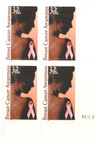
# 3081 PB - 1996 32c Breast Cancer Awareness
US #3081
1996 Breast Cancer Awareness
- Plate Block
- Issued to raise awareness of Breast Cancer
Stamp Category: Commemorative
Value: 32¢, First-Class mail rate
First Day of Issue: June 15, 1996
First Day City: Washington, DC
Printed by: Ashton-Potter (USA) Ltd.
Printing Method: Lithographed
Format: Panes of 20 (5 across, 4 down) from printing plates of 120 (8 across, 15 down)
Perforations: 11.1
Why the stamp was issued: The stamp was issued to increase awareness of breast cancer and the need for additional research, screening, and treatment. It kicked off a four-month public service campaign to raise awareness of the disease and encourage screening.
About the stamp design: The team behind the AIDS Awareness stamp (US #2806) also created the Breast Cancer Awareness stamp. Art director Howard Paine and designer Tom Mann incorporated a pink ribbon, the symbol of the disease, similar to the red ribbon on the AIDS Awareness stamp. The Breast Cancer Awareness stamp pictures the back of a woman, with her shadowed face turned to the side.
Special Design Details: The word “AWARENESS” is microprinted in the lower-right corner of the design.
First Day City: The First Day of Issue ceremony was held in Washington, DC, in connection with the Race for the Cure. This 5-kilometer race was the largest of its kind at the time. Diane Nannery, the main support of the stamp, was on hand for the ceremony.
Unusual fact about this stamp: The person who pushed for the USPS to issue a Breast Cancer awareness stamp was Diane Sackett Nannery, a Postal Service District Office supervisor from Long Island, New York. As a breast cancer survivor, Nannery saw the importance of a stamp to honor those who were fighting the disease and those who had lost their battle. Although Nannery lived to see the stamp issued, she died of breast cancer in 2004.
History the stamp represents: Breast cancer is the most common form of cancer in women. More than 184,000 women are diagnosed with the disease yearly. With education and awareness, however, breast cancer is no longer the death sentence it once was. Today, routine self-exams and regular mammograms give women a greater chance of detecting breast cancer early, when it is most treatable.
US #3081
1996 Breast Cancer Awareness
- Plate Block
- Issued to raise awareness of Breast Cancer
Stamp Category: Commemorative
Value: 32¢, First-Class mail rate
First Day of Issue: June 15, 1996
First Day City: Washington, DC
Printed by: Ashton-Potter (USA) Ltd.
Printing Method: Lithographed
Format: Panes of 20 (5 across, 4 down) from printing plates of 120 (8 across, 15 down)
Perforations: 11.1
Why the stamp was issued: The stamp was issued to increase awareness of breast cancer and the need for additional research, screening, and treatment. It kicked off a four-month public service campaign to raise awareness of the disease and encourage screening.
About the stamp design: The team behind the AIDS Awareness stamp (US #2806) also created the Breast Cancer Awareness stamp. Art director Howard Paine and designer Tom Mann incorporated a pink ribbon, the symbol of the disease, similar to the red ribbon on the AIDS Awareness stamp. The Breast Cancer Awareness stamp pictures the back of a woman, with her shadowed face turned to the side.
Special Design Details: The word “AWARENESS” is microprinted in the lower-right corner of the design.
First Day City: The First Day of Issue ceremony was held in Washington, DC, in connection with the Race for the Cure. This 5-kilometer race was the largest of its kind at the time. Diane Nannery, the main support of the stamp, was on hand for the ceremony.
Unusual fact about this stamp: The person who pushed for the USPS to issue a Breast Cancer awareness stamp was Diane Sackett Nannery, a Postal Service District Office supervisor from Long Island, New York. As a breast cancer survivor, Nannery saw the importance of a stamp to honor those who were fighting the disease and those who had lost their battle. Although Nannery lived to see the stamp issued, she died of breast cancer in 2004.
History the stamp represents: Breast cancer is the most common form of cancer in women. More than 184,000 women are diagnosed with the disease yearly. With education and awareness, however, breast cancer is no longer the death sentence it once was. Today, routine self-exams and regular mammograms give women a greater chance of detecting breast cancer early, when it is most treatable.




